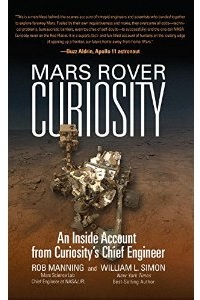Review: Mars Rover Curiosityby Jeff Foust
|
| “This is crazy,” Manning recalls Griffin saying as the EDL review ended. “It’s the right kind of crazy. So crazy it might just work.” |
Mars Rover Curiosity certainly falls into the latter category. The book’s final chapter, logically named “The Scientific Findings,” does discuss the initial scientific achievements enabled by the titular rover, but that isn’t the reason to read it. Instead, the book offers a detailed, compelling tale of the rover’s development from someone who was at the center of the effort. For those who want to know how the spacecraft sausage is made, this is the book for you.
Rob Manning, who authored the book with writer William Simon, officially joined the Mars Science Laboratory (MSL) program as chief engineer in 2007, two years before the originally scheduled launch date of the mission. However, as he recounts in the book, he was involved in the MSL concept far earlier, including early concepts developed at JPL in 2000 for a descent stage that would lower a rover to the surface on cables—the core of the “sky crane” concept that would eventually be adopted for MSL. (That name, Manning recounts, emerged after an early independent review of the concept, which included discussions with a pilot of a Sikorsky Skycrane helicopter.)
Curiosity’s first-of-its-kind landing system, featuring that sky crane, attracted a lot of attention, and concern, during the mission’s development, highlighted by NASA’s “Seven Minutes of Terror” video released in the months before that ultimately successful landing. Manning recalled a review of the landing system, early in MSL’s development, held at NASA Headquarters with administrator Mike Griffin in attendance. “This is crazy,” Manning recalls Griffin saying as the review ended. “It’s the right kind of crazy. So crazy it might just work.”
But, for all the attention its entry, descent, and landing (EDL) system got, the real problems with Curiosity were elsewhere. “We were spending so much time developing EDL and the sky crane, and working to get the blessings of review panels, that the rest of the project wasn’t really getting enough scrutiny,” Manning writes. Serving at the time as chief engineer of the overall Mars exploration program at JPL, he saw signs of work falling behind schedule within a constrained budget (originally priced at about $1 billion—“a bit more” than the combined cost of the Spirit and Opportunity rovers—MSL later had a budget of $1.6 billion, which would later grow to more than $2 billion). In 2007, JPL offered him the opportunity to work on MSL full time as the chief engineer to help keep the mission on track for a 2009 launch.
Soon after taking on his new role, Manning became skeptical a 2009 launch was viable: there were too many problems that had to be solved. The challenge he faced was trying to prove it to agency leadership: “if you want decisions to be made, you will need defensible data,” veteran JPL engineer Gentry Lee advised him. When Manning finally got that data—there was no longer enough time in the schedule to assemble and test all the spacecraft components—he found it “both depressing and relieving.” While NASA, when announcing the two-year delay in 2008, suggested the delay was largely due to problems with actuators used on the rover, Manning’s account makes it clear the problems were far more fundamental.
| One message that comes out of Mars Rover Curiosity is that it’s remarkable that the success rate of Mars missions is as high as it is. |
That delay—and extra funding that came with it—allowed the MSL team to get the project back on track, successfully launching it in November 2011. There were still problems along the way though, from a wiring fix needed while MSL was at Cape Canaveral being prepared for launch to a computer glitch after launch that threatened the spacecraft’s ability to orient itself and perform trajectory correction maneuvers. The hard work, though, paid off: Curiosity landed safely on Mars, its complex, often derided EDL system working flawlessly.
One message that comes out of Mars Rover Curiosity is that it’s remarkable, even given high-profile failures like Mars Climate Orbiter and Mars Polar Lander, that the success rate of Mars missions is as high as it is. So many things need to go just right for a mission to be a successful, and unforeseen issues can jeopardize the mission. Manning recalls a computer timing issue discovered on Spirit just days before its scheduled landing that, had it gone unchecked, likely would have lost the mission. (Those worries don’t end after landing: the book’s final chapter recounts a computer glitch more than six months later that threatened Curiosity.)
Mars Rover Curiosity is a fascinating look at the development of one of NASA’s flagship planetary science missions, and the latest step towards the agency’s long-term goal of humans on Mars. Even if you’re more interested in the science enabled by Curiosity, this book is a reminder that the development of spacecraft that make that research possible is far more challenging than NASA often makes it appear.
